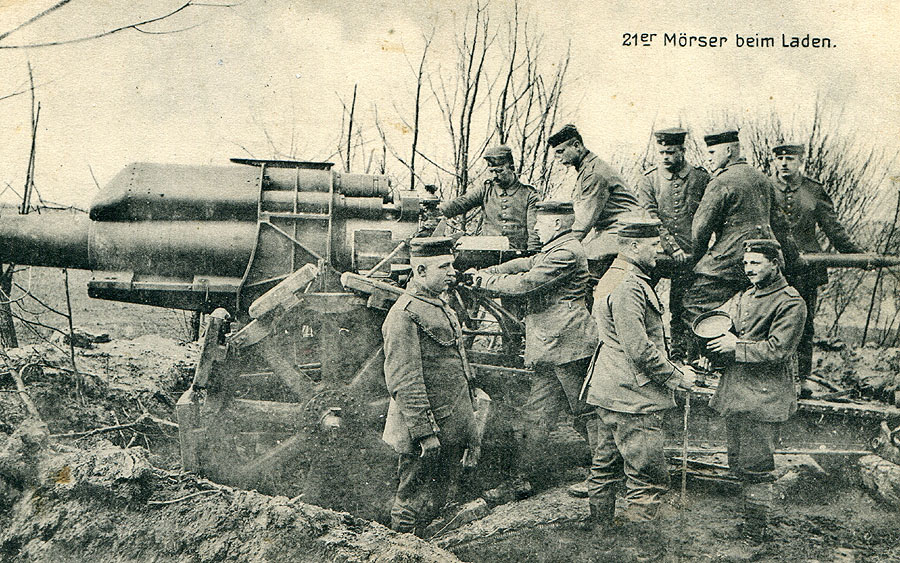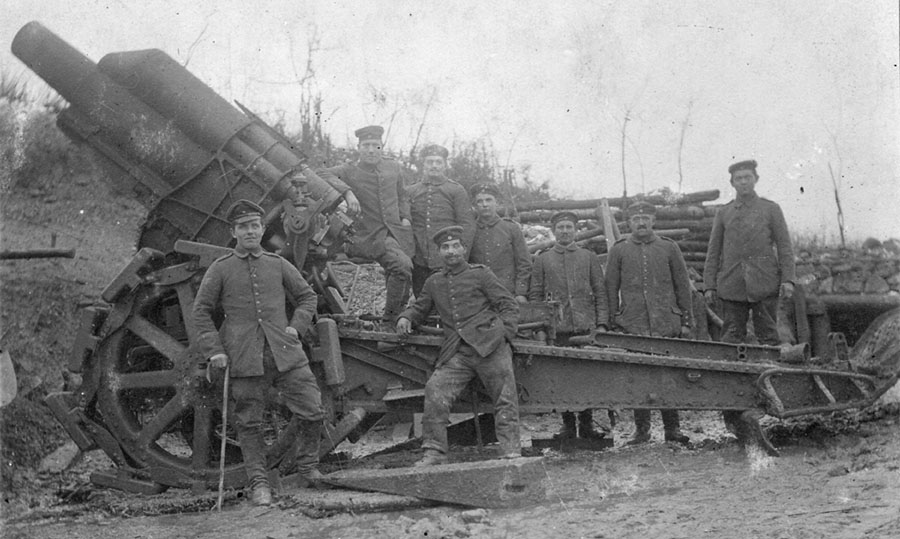| 21cm Mörser 10/16 Cartridge Casing | ||
 | ||
| 21cm cartridge casing for the Krupp 21 cm Mörser 10/16. To illustrate the size, the casing is photographed with an original issued Ersatz Model 1915 Preußen Artillerie Filzhelm (felt helmet) which would have been worn many of the troops firing this weapon. 21cm Mörser 10/16 Cartridge Casing Data:
|
||
 | ||
| A close-up of the head stamping on the base. Marked: PATRONENFABRIK (cartridge factory) KARLSRUHE manufactured "Nov 1918" with the standard twin flaming bombs for this manufacturer. "124" is the lot number of that batch of cases which were made during 1917. Sp255 is the control/inspection mark of the manufacturer Patronenfabrik Karlsruhe. | ||
| ||
| 21cm Mörser Model 1910 | ||
 | ||
| One of the most numerous and important weapons in the inventory of the Fußartillerie (Foot Artillery) was the Model 1910 21cm Mörser (known to Troops simply as "Der Mörser"). When the War started in 1914, the German Army was able to field 216 of these large howitzers. Due to the large projectile and impressive range, these howitzers soon became the standard indirect fire weapon. Like many large calibre weapons of the time, the 21cm Mörser had to be towed by motor transport in two loads due to the weight. In this photo a crew of a 21cm Mörser 10 with the early short 2.57m (8 ft 5 inches) L/12 barrel pose beside their Mörser. The 114 kg (252 lbs) high explosive projectile is siting in the loading tray which was swung manually up to level with the breech when the barrel was levelled. | ||
21cm Mörser 10/16 Data:
| ||
 | ||
| In this posed photo two Kanoniers (Gunners) pose with the 114 kg (252 lbs) high explosive projectile with the loading tray in the vertical position and one Kanonier is (somewhat prematurely) holding the firing lanyard. | ||
 | ||
| This photo shows the Rad-guertel (wheel pads) to the circumference to dissipate the ground pressure and the "run-back ramps" behind the wheels which allowed the cannon to run-back on recoil and then roll back into position. The howitzer in nicely marked on the trail as belonging to Fußartillerie-Regt. von Linger (Ostpreußisches) Nr.1 (Königsberg i.Pr.) I Armee Korps, 5th Battery (Mörser). | ||
 | ||
| This common commercially produced post card is poor quality, but shows one Kanonier holding the 21cm cartridge casing which is the subject of this page. Of interest, this Mörser has no shield. | ||
 | ||
| Another posed photo of a 21cm M10 Mörser crew. This example also does not have a shield. | ||
| 21cm Mörser Lange Model 1916 | ||
 Photo courtesy Brett Butterworth Photo Archives | ||
| As with all cannons and howitzers that entered the war in 1914, it soon became clear that an increase in range was required due to counter- battery fire from enemy artillery. The result was that the howitzer barrel was lengthened from L/12 to L/14.5 (2.13 meters/7 feet to 3.09 meters/10 feet 4 inches). This photo shows the lengethend barrel of the 21cm Mörser Model 1916 and is an excellent study of the Dürkopp-Artillerie-Kraftschlepper (Dürkopp artillery tractor) and Lastenverteilergerät (load distributor) for heavy cannon and howitzer which lowered the ground pressure by suspending the gun between the tractor and a trailer. When the war came to an end in November 1918, the 21 cm Mörsers of the German Fußartillerie (Foot Artillery) had fired approximately seven million high explosive projectiles, many which still lay under the soil of France and Belgium. | ||
 | ||
| Come'on! Who doesn't want a Mörser? While visiting the incredible historic Québec Citadel in Québec Canada home of the famous Royal 22nd Régiment (Royal 22nd Canadian infantry regiment) for a work trip in 2011, I turned a corner and there was a 21cm Mörser M1916 Lange! As you can see in the photo, I never miss a chance to run over to a cannon or howitzer to look it over. It is amazing. | ||
 |
